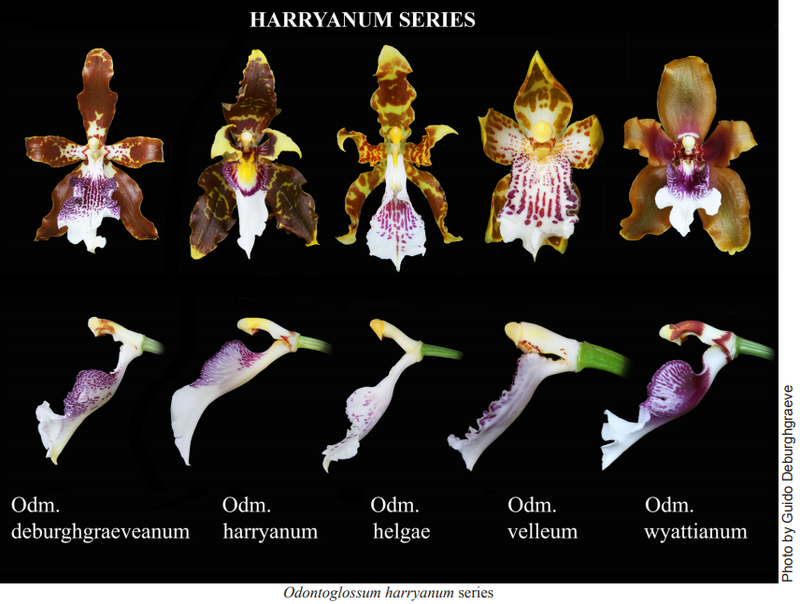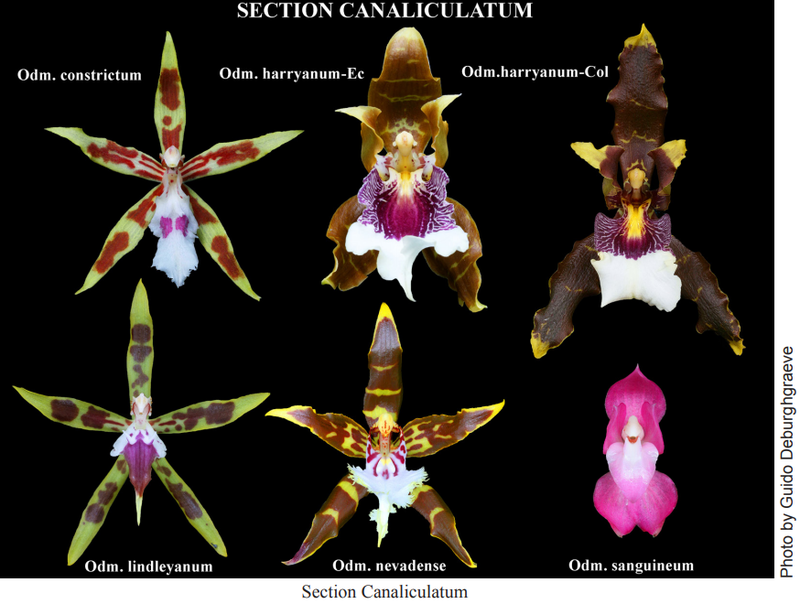In response to the musings by Andy Easton that Odontoglossum deburghgraeveanum is a natural hybrid between Odm. harryanum and Odm. wyattianum, I just want to add some comments based on observations in the field. The original discovery of Odm. harryanum took place in the northern part of the central cordillera in Antioquia, Colombia, in 1886. There is no doubt about that. The holotype and contemporary illustrations correlate very well with what we have seen coming from that area today. For some reason Odm. harryanum disappeared from cultivation early on and the origin of this species remained a mystery for many years. It was apparently not seen again until the early nineteen sixties. About a decade later plants that look very much like typical Odm. harryanum were found in Ecuador by the Salesian missionary priest Angel Andreetta. This Ecuadorean form collected by Andreetta was included in Leonore Bockemühl’s treatment of the genus in 1989 as Odm. “wyattianum”. This was unfortunate since there is no real similarity between the Ecuadorean form of what I conclude is Odm. harryanum and the Peruvian Odm. wyattianum. Odontoglossum harryanum occurs as far south as the Loja area in southern Ecuador where plants have been collected between Loja and Zamora. These plants look just like the other plants from Ecuador and are virtually the same as the form from Colombia.
The question whether the Colombian form of Odm. harryanum is distinct enough from the Ecuadorean form to represent a separate species is frequently discussed, but personally I prefer to keep them together. There is much more that keeps them together than separates them. To my knowledge, no plants of Odm. wyattianum have ever been documented from Ecuador. This species appears first in the Huanuco region in central Peru and further to the south to the Cusco and Ayacucho regions. The morphology and general appearance of Odm. harryanum and Odm. wyattianum can be superficially similar at first sight, but are quite distinct in reality. Particularly in the shape of the column which easily separates these species. I am also not familiar with any intermediate forms between these species that could represent a natural hybrid, and to my knowledge the geographic distributions do not overlap. There is another species in this complex, however, that is known from southern Ecuador and that looks kind of similar to Odm. deburghgraeveanum, and that is Odm. helgae. This latter species is known from central Ecuador to northern Peru and actually fills the distribution gap between Odm. harryanum and Odm. wyattianum. The shape of the flower of Odm. helgae is so unique and different from all other species in the harryanum complex though that no misidentifications should be possible.
 So where does Odm. deburghgraeveanum fit in? Well, that is indeed a good question. In the original description we speculated that it could be a natural hybrid between Odm. harryanum and possibly the sympatric Odm. velleum, but finally dismissed that idea. The morphology of the flower of Odm. deburghgraeveanum, particularly the column, does not seem to be the result of the crossing between any species in this complex. The real geographic origin for this taxon was also a mystery for some time.
So where does Odm. deburghgraeveanum fit in? Well, that is indeed a good question. In the original description we speculated that it could be a natural hybrid between Odm. harryanum and possibly the sympatric Odm. velleum, but finally dismissed that idea. The morphology of the flower of Odm. deburghgraeveanum, particularly the column, does not seem to be the result of the crossing between any species in this complex. The real geographic origin for this taxon was also a mystery for some time.
We finally located some plants in the Junín and Cusco regions in Peru where it actually occurs sympatric with Odm. wyattianum. But apparently these species flower at different times of the year in the wild. At least that is what we have been able to conclude based on the limited observations we have. Could Odm. deburghgraeveanum be a natural hybrid between Odm. wyattianum and something else? Well, I don’t want to dismiss this possibility altogether, but I highly doubt it. I cannot see what other sympatric Odontoglossum species would produce flowers like those of Odm. deburghgraeveanum in a cross with Odm. wyattianum. There are several species to choose between though and the only way to find out is to cross Odm. wyattianum with all of the others and prove me wrong. Sympatric species are Odm. ariasii, Odm. blandum, Odm. epidendroides, Odm. filamentosum, Odm. juninense, Odm. multistellare, Odm. praestans, and Odm. tenuifolium. Have fun!

